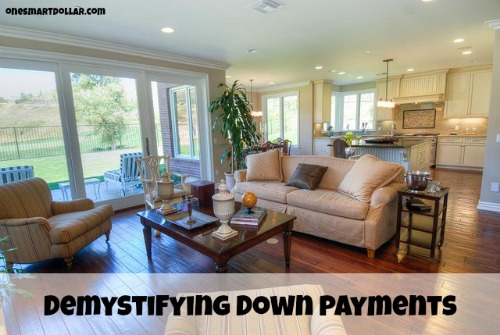
It’s hard to have 20/20 vision as a prospective home buyer – especially considering all the mortgage myths circulating that can cloud your judgment, including one of the biggest whoppers of them all: the notion that you always need 20% down to purchase a home.
Fact is, that 20% down payment rule was yesterday’s news. Today, there are loan programs available to qualified borrowers that allow you to put as anywhere from 3.5% to no money down on eligible properties.
Separating fact from fiction when it comes to down payments can give you better peace of mind and purchasing confidence. And knowing what low- to no-down-payment options are available can result in substantial savings and a faster path to homeownership.
Defining Down Payments
First, it’s important to understand what a down payment is and why some lenders require or encourage a larger down payment. A real estate down payment is the amount of money you put down toward the buying of a property – it’s the amount you can afford to pay out of your own pocket that doesn’t have to be borrowed. The bigger your down payment, the less money you have to borrow and the lower your monthly payment. The lower your principal balance owed, the less you will pay over the life of your loan in interest.
Every lender or mortgage program designates a particular minimum down payment amount. You can put down more if you have more available, but you at least have to pay the minimum down payment.
“The down payment can be anything the lender will approve you at,” Dana Graham, Realtor with Rolling Hills, Calif.-based Berkshire Hathaway California Properties, says, adding that keeping some funds in reserve can actually be looked upon favorably by some lenders. “At some point, the lender will put more value on you having a certain amount of rainy day money in your bank account.”
Eric Meermann, certified financial planner with Palisades Hudson Financial Group in Scarsdale, N.Y., says many aren’t aware that lenders have relaxed the old standard of 20% down minimum.
“That’s good news for people who want to take advantage today of low interest rates, because there are reasonable housing prices in many markets right now,” says Meermann.
Note that most lenders of conventional loans require you to pay for private mortgage insurance, or “PMI,” when you put down less than 20%. PMI is an insurance policy designed to protect the lender from the possibility of you defaulting on your obligation to repay the loan. However, there are ways around PMI you can discuss with your lender – including choosing a borrower-paid single premium mortgage insurance (typically an upfront charge which allows you to buy out of the PMI for the life of the loan) or pursuing a piggyback mortgage (which enables you to take out a second mortgage to cover part of the down payment and avoid PMI).
Why Less Can Be More
Common sense says it’s wise to put down a larger down payment – not only to avoid PMI, but to owe less over the life of your loan. But many experts will tell you that this strategy is economically dicey.
“The lower the down payment, the higher your return on investment if the home appreciates, and the greater the percentage loss if the home loses value,” says Casey Fleming, mortgage advisor with C2 Financial Corporation in San Francisco and author of The Loan Guide: How to Get the Best Possible Mortgage. “A lower down payment minimizes your risk of catastrophic loss because you don’t have that much put into the investment.”
Additionally, making a low down payment allows you to keep more of your money in liquid and accessible accounts/assets that can be tapped in the event of an emergency. By contrast, once you make your down payment and purchase your home, it’s not so easy to get that money back (unless you sell the home) or tap into your home’s equity.
“Your initial down payment is expensive and hard, if not impossible, to pull out of the home,” Fleming adds.
Further, there’s always the risk that your home’s value could drop in the future, which means that the larger down payment you make today could be a bad investment that yields a negative return on those dollars tomorrow.
The Lowdown On Low- To No-Down Payment Loans
Popular mortgage loan programs currently available that permit you to make a low down payment include:
- FHA loan – minimum 3.5% down payment
- Fannie Mae HomeReady loan– minimum 3% down payment
- Freddie Mac Home Possible loan – minimum 3% down payment
- VA loan – 0% down payment required
- USDA loan – 0% down payment required
- Conventional loan (with PMI) – minimum 3% down payment
- Jumbo loan – minimum 10% down payment
“In addition, there are many national, state and county grant programs that allow consumers to utilize grants for down payment assistance should a consumer not have the 3.5% or 3% down needed for the FHA, Fannie Mae or Freddie Mac loans,” says David J. Hosterman, branch manager with Castle Cook Mortgage in Greenwood Village, Colo. “Furthermore, a lot of these programs are not just for first-time home buyers but home buyers in general.”
Coming Up With The Cash
Fleming says the best candidates for a low down payment are those with secure income, including buyers with:
- a low likelihood of unemployment or whose income is not based entirely on commission
- abundant reserves – buyers with plenty of savings after closing are more likely to withstand a financial shock
- great credit habits – home buyers who do not abuse credit and carry either very small or no revolving balances are much less likely to run up their credit cards after buying a home and, therefore, less likely to create a financial hardship for themselves.
To help raise the funds necessary for your minimum down payment, prepare to make some sacrifices and pursue alternative strategies if necessary, including tightening the belt and enacting a strict budget plan.
“Scrimp and save – forgo that $200 dinner or that cruise on the Mediterranean if you really want to have your own place, and be willing to get there in steps,” says Graham.
Also, consider asking a relative or friend for financial assistance in the form of a gift. Most lenders require the gift to come from a family member, and the donor must compose a gift letter addressed to the lender verifying that the monies given are a gift – not a loan. A private loan from a friend or family member may be denied as a source of down payment funding.
To help determine your eligibility to qualify for a low- to no-down payment loan and explore savings strategies, consult with an experienced mortgage professional.

